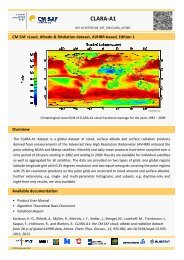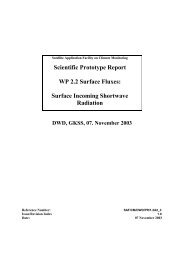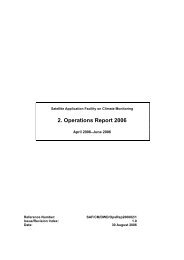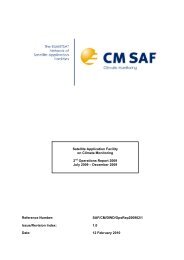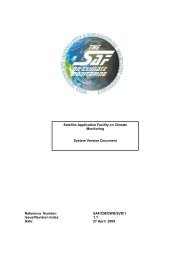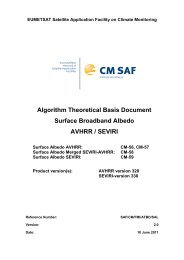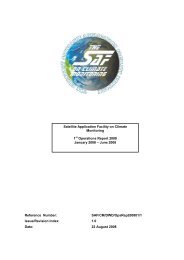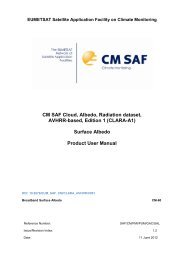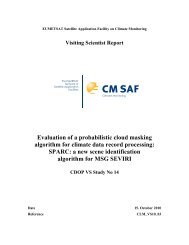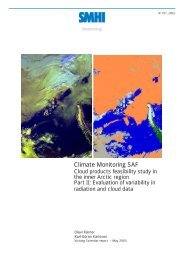Aerosol retrievals from METEOSAT-8 - CM SAF
Aerosol retrievals from METEOSAT-8 - CM SAF
Aerosol retrievals from METEOSAT-8 - CM SAF
You also want an ePaper? Increase the reach of your titles
YUMPU automatically turns print PDFs into web optimized ePapers that Google loves.
<strong>SAF</strong> on Climate Monitoring Visiting Scientists Report Doc. No: 1.0<br />
Issue : 1.0<br />
Date : 4 October 2006<br />
way that the group will identify unambiguously specific cloudy or clear sky condition. Each group<br />
may contain tests aimed at detecting clouds or rejecting unphysical clear sky conditions. The<br />
different groups are then arranged in such a way that the independence between the tests is<br />
maximized. A different weight is assigned to each group of cloud detection tests. Additionally,<br />
groups have been implemented to specifically detect clear sky conditions and a similar weighting is<br />
applied. Finally, the results of all the tests and the sum of the weights are used to generate a<br />
summarized cloud mask that includes four confident levels: clear certain, clear uncertain, cloud<br />
uncertain and cloudy certain (similar to the cloud mask summary provided by the operational<br />
MODIS cloud mask product MOD35).<br />
Statistics on clouds and then on clear sky pixels available for aerosols detection are presented in this<br />
appendix based on results <strong>from</strong> this cloud detection scheme.<br />
Over the entire disk as observed by SEVIRI, the cloud mask of MODIS Aqua at 1kmx1km<br />
resolution (overpass at 14:30 UT) has been built <strong>from</strong> the composite of different orbits (see Fig. 1).<br />
In this map four classes of pixels can be found: clear confident in white, probably clear in red,<br />
probably cloudy in purple and confident cloudy in black. Only pixels flagged as clear confident are<br />
kept for aerosols <strong>retrievals</strong>. The histogram presented in Figure 2 shows the number of pixels which<br />
can be used for MODIS to derive aerosols properties. Almost 38% of the pixels are flagged as clear<br />
confident.<br />
Figure 3 shows the cloud mask <strong>from</strong> SEVIRI for the same day at 14:30 UT over the entire disk.<br />
Four classes are possible: clear certain (in light blue), probably clear (in yellow), probably cloudy<br />
(in red) and confident cloudy (black). Whereas MODIS AQUA observes only once a location the<br />
afternoon at 14:30UTC (MODIS TERRA overpass is morning at 10:30UTC), MSG/SEVIRI can<br />
observe every 15 minutes the same location. Taking into account the time period 12:00-16:00 UTC,<br />
16 observations of the same location are then available. One can note that we can compare with<br />
MODIS TERRA using the period 08:00-12:00 UTC. Figure 4 shows the number of clear sky<br />
observations for each SEVIRI pixels.<br />
Essential information is the spatial coverage of the product. The spatial coverage of the aerosols<br />
products <strong>from</strong> MODIS-AQUA and SEVIRI can be compared in Figure 5. These figures also<br />
indicate how rich is the set of useful measurements available <strong>from</strong> SEVIRI to derive aerosols<br />
- 44 -



